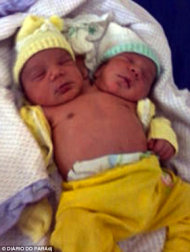
Thursday, December 22, 2011
OLL LEWIS: Yesterday's News Today
On this day in 1938 the first modern coelacanth species was discovered off the South African coast.
And now the news:
Looking for benefits in birdsong
Frankincense tree facing uncertain future
Will Antarctic Worms Warm to Changing Climate?
Invisible fungi crucial for rainforest diversity
Concern at poaching of Kerry red deer
Journey's end as red kite is found poisoned
Dear little fellow:http://www.arkive.org/coelacanth/latimeria-chalumnae/video-06.html
TWO HEADED BABY IN BRAZIL
"When doctors scanned her they realized that the baby had two heads and that a normal birth would be a great risk both for mother and baby," hospital director Claudionor Assis de Vasconcelos told Brazil's O Povo newspaper. "The caesarean took an hour because the baby was sitting down."
"Despite all the problems we have as a small interior hospital we managed to save both mother and baby, which was our aim," he said. "And for us it was a great surprise to find out that the child was in really good health."
De Nazare was expecting twins and only found out about the two-headed child minutes before doctors advised her to have a caesarean birth in order to save both her life and that of her baby. Along with two heads, the 9.9 pound newborns have separate spines.
In some two-headed births where one brain is less developed, one head is removed in order to save the child's life. But rarer cases like this one, where there are two functioning brains, complicates the decision making process for doctors.
"If both their brains are functioning, how are we going to choose which head to remove?" said Neila Dahas, director of the Santa Casa hospital. "We are not considering the possibility of surgery. What we've got to think about at this moment is to maintain the children in good condition and see how they will develop."
Conjoined twins sharing a body, but with separate heads, are extremely rare but not without precedent. This is the second such birth in Brazil this year. However, the other child died after a few hours because of a lack of oxygen to one of the child's heads.
There have been at least 14 dicephalic conjoined twins born over the past 200 years.
CFZ CANADA: An introduction to Canadian Water Monsters (Guest blogger Dale Drinnon)
 CFZ Canada had put up an article earlier thisyear in which it was stated that Plesiosaur fossils had been found in thedeposits left behind by Glacial Lake Agassiz. This would be unusual for severalreasons, not the least of which would be that the lake would be pretty much perpetual icewater. I had also discovered something about Lake Monsters in North America during my studies of the reports, most of which I shall explain later in this article.....Read all about it
CFZ Canada had put up an article earlier thisyear in which it was stated that Plesiosaur fossils had been found in thedeposits left behind by Glacial Lake Agassiz. This would be unusual for severalreasons, not the least of which would be that the lake would be pretty much perpetual icewater. I had also discovered something about Lake Monsters in North America during my studies of the reports, most of which I shall explain later in this article.....Read all about it


















